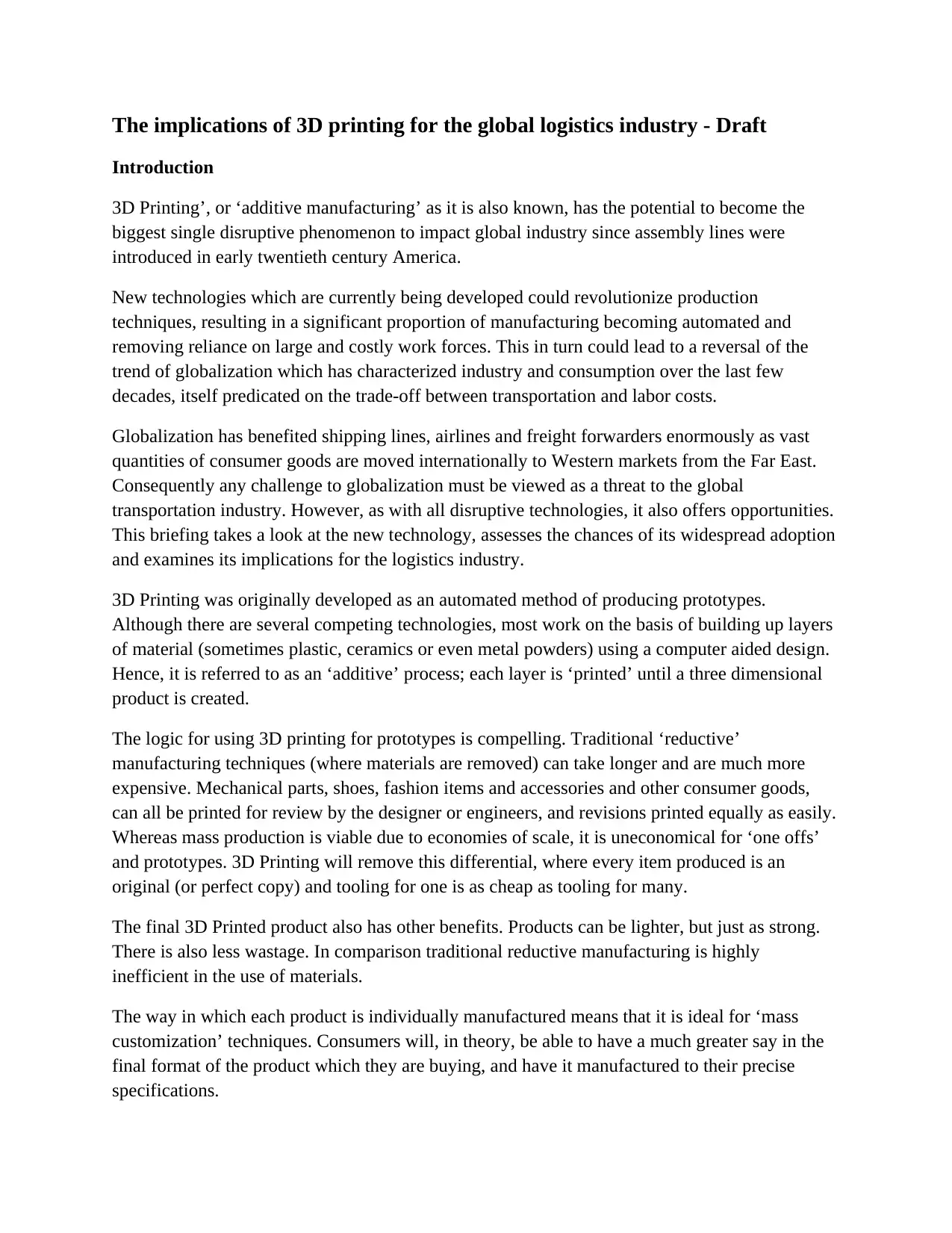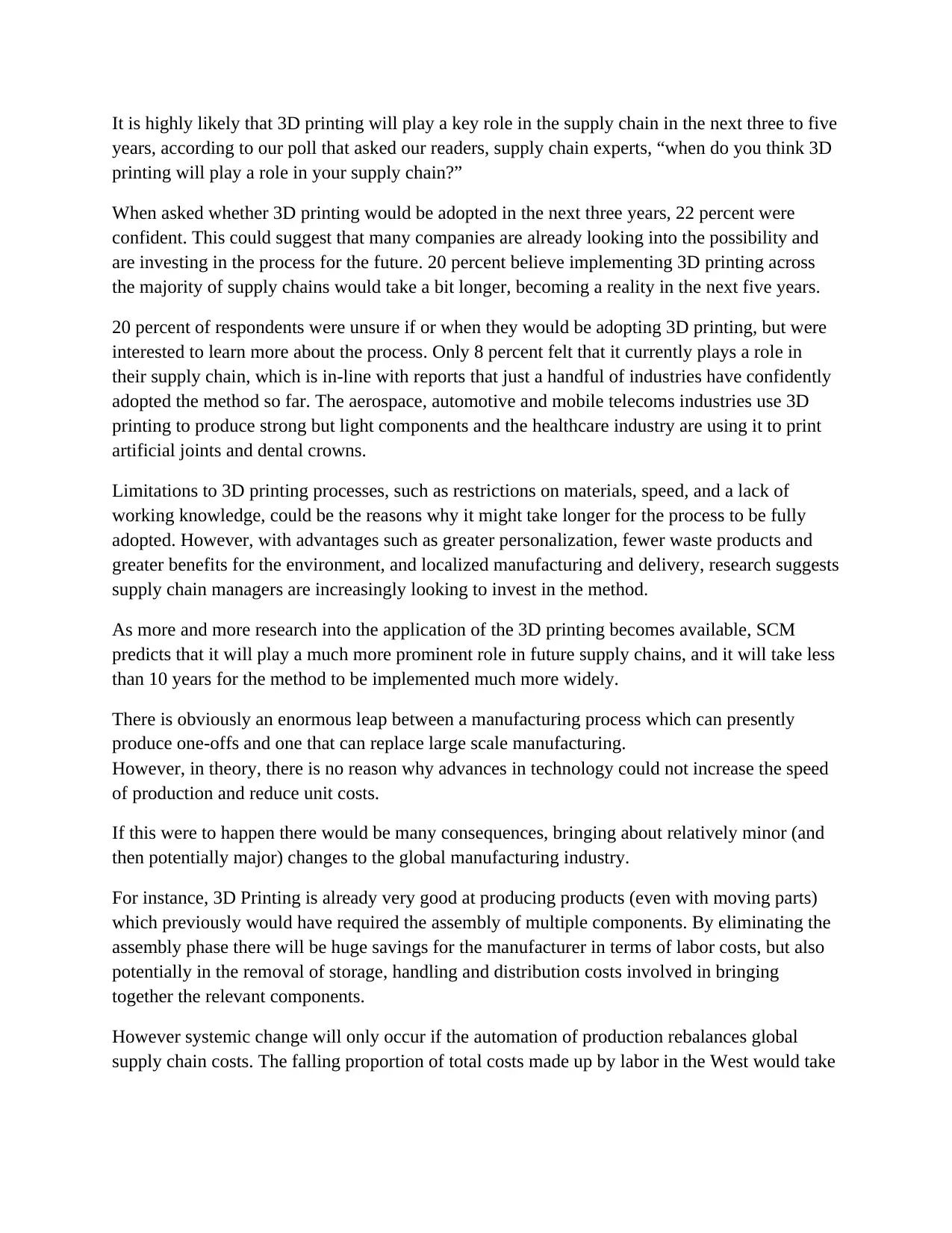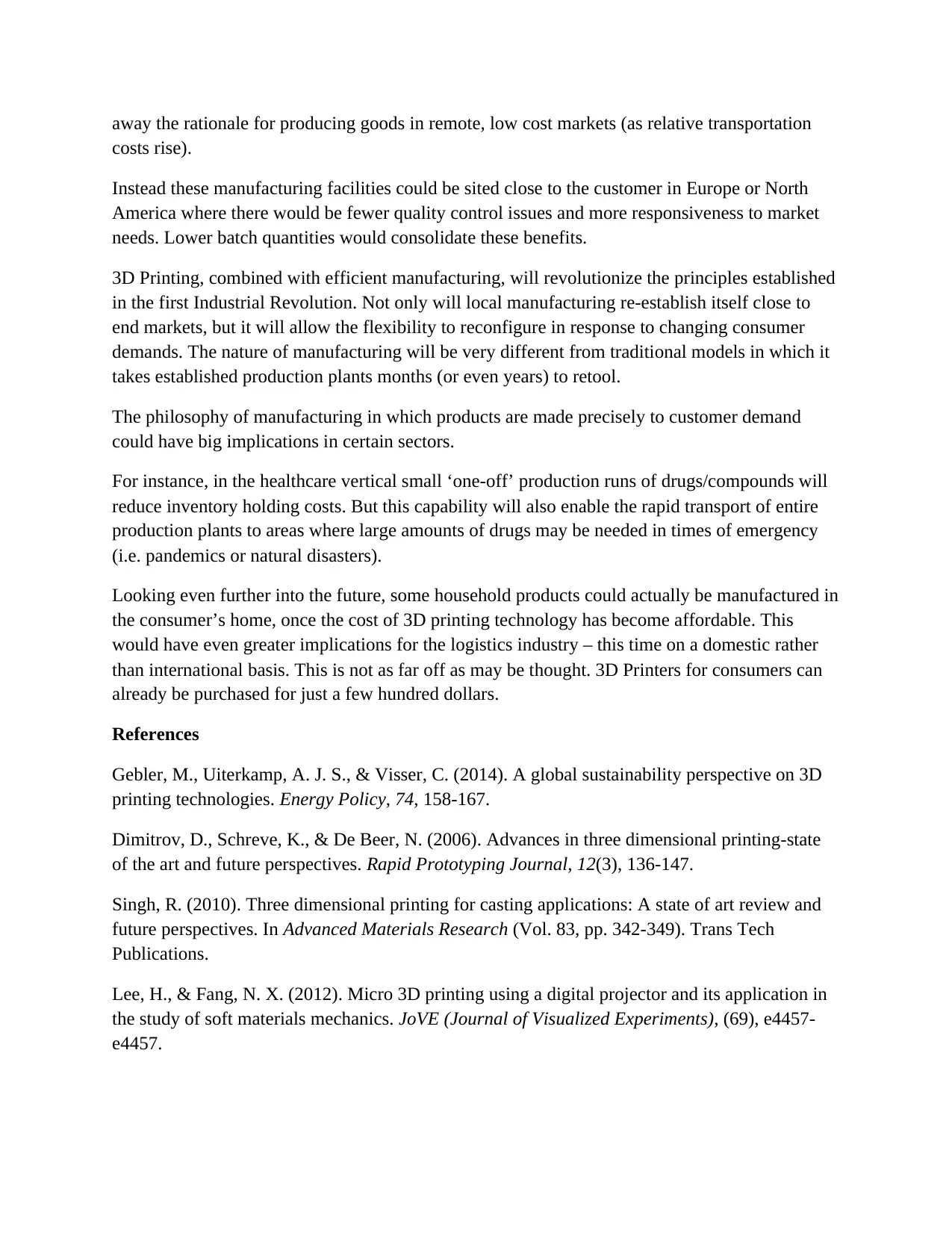The Implications of 3D Printing for Global Logistics Industry
VerifiedAdded on 2019/09/23
|4
|1518
|182
Report
AI Summary
The article discusses the implications of 3D printing on the global logistics industry. It highlights how 3D printing can revolutionize production techniques, leading to a reversal of globalization and changing the supply chain dynamics. The technology has potential benefits such as mass customization, reduced waste, and localized manufacturing. While there are limitations to its adoption, research suggests that it will play a significant role in future supply chains within the next decade.
Contribute Materials
Your contribution can guide someone’s learning journey. Share your
documents today.

The implications of 3D printing for the global logistics industry - Draft
Introduction
3D Printing’, or ‘additive manufacturing’ as it is also known, has the potential to become the
biggest single disruptive phenomenon to impact global industry since assembly lines were
introduced in early twentieth century America.
New technologies which are currently being developed could revolutionize production
techniques, resulting in a significant proportion of manufacturing becoming automated and
removing reliance on large and costly work forces. This in turn could lead to a reversal of the
trend of globalization which has characterized industry and consumption over the last few
decades, itself predicated on the trade-off between transportation and labor costs.
Globalization has benefited shipping lines, airlines and freight forwarders enormously as vast
quantities of consumer goods are moved internationally to Western markets from the Far East.
Consequently any challenge to globalization must be viewed as a threat to the global
transportation industry. However, as with all disruptive technologies, it also offers opportunities.
This briefing takes a look at the new technology, assesses the chances of its widespread adoption
and examines its implications for the logistics industry.
3D Printing was originally developed as an automated method of producing prototypes.
Although there are several competing technologies, most work on the basis of building up layers
of material (sometimes plastic, ceramics or even metal powders) using a computer aided design.
Hence, it is referred to as an ‘additive’ process; each layer is ‘printed’ until a three dimensional
product is created.
The logic for using 3D printing for prototypes is compelling. Traditional ‘reductive’
manufacturing techniques (where materials are removed) can take longer and are much more
expensive. Mechanical parts, shoes, fashion items and accessories and other consumer goods,
can all be printed for review by the designer or engineers, and revisions printed equally as easily.
Whereas mass production is viable due to economies of scale, it is uneconomical for ‘one offs’
and prototypes. 3D Printing will remove this differential, where every item produced is an
original (or perfect copy) and tooling for one is as cheap as tooling for many.
The final 3D Printed product also has other benefits. Products can be lighter, but just as strong.
There is also less wastage. In comparison traditional reductive manufacturing is highly
inefficient in the use of materials.
The way in which each product is individually manufactured means that it is ideal for ‘mass
customization’ techniques. Consumers will, in theory, be able to have a much greater say in the
final format of the product which they are buying, and have it manufactured to their precise
specifications.
Introduction
3D Printing’, or ‘additive manufacturing’ as it is also known, has the potential to become the
biggest single disruptive phenomenon to impact global industry since assembly lines were
introduced in early twentieth century America.
New technologies which are currently being developed could revolutionize production
techniques, resulting in a significant proportion of manufacturing becoming automated and
removing reliance on large and costly work forces. This in turn could lead to a reversal of the
trend of globalization which has characterized industry and consumption over the last few
decades, itself predicated on the trade-off between transportation and labor costs.
Globalization has benefited shipping lines, airlines and freight forwarders enormously as vast
quantities of consumer goods are moved internationally to Western markets from the Far East.
Consequently any challenge to globalization must be viewed as a threat to the global
transportation industry. However, as with all disruptive technologies, it also offers opportunities.
This briefing takes a look at the new technology, assesses the chances of its widespread adoption
and examines its implications for the logistics industry.
3D Printing was originally developed as an automated method of producing prototypes.
Although there are several competing technologies, most work on the basis of building up layers
of material (sometimes plastic, ceramics or even metal powders) using a computer aided design.
Hence, it is referred to as an ‘additive’ process; each layer is ‘printed’ until a three dimensional
product is created.
The logic for using 3D printing for prototypes is compelling. Traditional ‘reductive’
manufacturing techniques (where materials are removed) can take longer and are much more
expensive. Mechanical parts, shoes, fashion items and accessories and other consumer goods,
can all be printed for review by the designer or engineers, and revisions printed equally as easily.
Whereas mass production is viable due to economies of scale, it is uneconomical for ‘one offs’
and prototypes. 3D Printing will remove this differential, where every item produced is an
original (or perfect copy) and tooling for one is as cheap as tooling for many.
The final 3D Printed product also has other benefits. Products can be lighter, but just as strong.
There is also less wastage. In comparison traditional reductive manufacturing is highly
inefficient in the use of materials.
The way in which each product is individually manufactured means that it is ideal for ‘mass
customization’ techniques. Consumers will, in theory, be able to have a much greater say in the
final format of the product which they are buying, and have it manufactured to their precise
specifications.
Secure Best Marks with AI Grader
Need help grading? Try our AI Grader for instant feedback on your assignments.

It is highly likely that 3D printing will play a key role in the supply chain in the next three to five
years, according to our poll that asked our readers, supply chain experts, “when do you think 3D
printing will play a role in your supply chain?”
When asked whether 3D printing would be adopted in the next three years, 22 percent were
confident. This could suggest that many companies are already looking into the possibility and
are investing in the process for the future. 20 percent believe implementing 3D printing across
the majority of supply chains would take a bit longer, becoming a reality in the next five years.
20 percent of respondents were unsure if or when they would be adopting 3D printing, but were
interested to learn more about the process. Only 8 percent felt that it currently plays a role in
their supply chain, which is in-line with reports that just a handful of industries have confidently
adopted the method so far. The aerospace, automotive and mobile telecoms industries use 3D
printing to produce strong but light components and the healthcare industry are using it to print
artificial joints and dental crowns.
Limitations to 3D printing processes, such as restrictions on materials, speed, and a lack of
working knowledge, could be the reasons why it might take longer for the process to be fully
adopted. However, with advantages such as greater personalization, fewer waste products and
greater benefits for the environment, and localized manufacturing and delivery, research suggests
supply chain managers are increasingly looking to invest in the method.
As more and more research into the application of the 3D printing becomes available, SCM
predicts that it will play a much more prominent role in future supply chains, and it will take less
than 10 years for the method to be implemented much more widely.
There is obviously an enormous leap between a manufacturing process which can presently
produce one-offs and one that can replace large scale manufacturing.
However, in theory, there is no reason why advances in technology could not increase the speed
of production and reduce unit costs.
If this were to happen there would be many consequences, bringing about relatively minor (and
then potentially major) changes to the global manufacturing industry.
For instance, 3D Printing is already very good at producing products (even with moving parts)
which previously would have required the assembly of multiple components. By eliminating the
assembly phase there will be huge savings for the manufacturer in terms of labor costs, but also
potentially in the removal of storage, handling and distribution costs involved in bringing
together the relevant components.
However systemic change will only occur if the automation of production rebalances global
supply chain costs. The falling proportion of total costs made up by labor in the West would take
years, according to our poll that asked our readers, supply chain experts, “when do you think 3D
printing will play a role in your supply chain?”
When asked whether 3D printing would be adopted in the next three years, 22 percent were
confident. This could suggest that many companies are already looking into the possibility and
are investing in the process for the future. 20 percent believe implementing 3D printing across
the majority of supply chains would take a bit longer, becoming a reality in the next five years.
20 percent of respondents were unsure if or when they would be adopting 3D printing, but were
interested to learn more about the process. Only 8 percent felt that it currently plays a role in
their supply chain, which is in-line with reports that just a handful of industries have confidently
adopted the method so far. The aerospace, automotive and mobile telecoms industries use 3D
printing to produce strong but light components and the healthcare industry are using it to print
artificial joints and dental crowns.
Limitations to 3D printing processes, such as restrictions on materials, speed, and a lack of
working knowledge, could be the reasons why it might take longer for the process to be fully
adopted. However, with advantages such as greater personalization, fewer waste products and
greater benefits for the environment, and localized manufacturing and delivery, research suggests
supply chain managers are increasingly looking to invest in the method.
As more and more research into the application of the 3D printing becomes available, SCM
predicts that it will play a much more prominent role in future supply chains, and it will take less
than 10 years for the method to be implemented much more widely.
There is obviously an enormous leap between a manufacturing process which can presently
produce one-offs and one that can replace large scale manufacturing.
However, in theory, there is no reason why advances in technology could not increase the speed
of production and reduce unit costs.
If this were to happen there would be many consequences, bringing about relatively minor (and
then potentially major) changes to the global manufacturing industry.
For instance, 3D Printing is already very good at producing products (even with moving parts)
which previously would have required the assembly of multiple components. By eliminating the
assembly phase there will be huge savings for the manufacturer in terms of labor costs, but also
potentially in the removal of storage, handling and distribution costs involved in bringing
together the relevant components.
However systemic change will only occur if the automation of production rebalances global
supply chain costs. The falling proportion of total costs made up by labor in the West would take

away the rationale for producing goods in remote, low cost markets (as relative transportation
costs rise).
Instead these manufacturing facilities could be sited close to the customer in Europe or North
America where there would be fewer quality control issues and more responsiveness to market
needs. Lower batch quantities would consolidate these benefits.
3D Printing, combined with efficient manufacturing, will revolutionize the principles established
in the first Industrial Revolution. Not only will local manufacturing re-establish itself close to
end markets, but it will allow the flexibility to reconfigure in response to changing consumer
demands. The nature of manufacturing will be very different from traditional models in which it
takes established production plants months (or even years) to retool.
The philosophy of manufacturing in which products are made precisely to customer demand
could have big implications in certain sectors.
For instance, in the healthcare vertical small ‘one-off’ production runs of drugs/compounds will
reduce inventory holding costs. But this capability will also enable the rapid transport of entire
production plants to areas where large amounts of drugs may be needed in times of emergency
(i.e. pandemics or natural disasters).
Looking even further into the future, some household products could actually be manufactured in
the consumer’s home, once the cost of 3D printing technology has become affordable. This
would have even greater implications for the logistics industry – this time on a domestic rather
than international basis. This is not as far off as may be thought. 3D Printers for consumers can
already be purchased for just a few hundred dollars.
References
Gebler, M., Uiterkamp, A. J. S., & Visser, C. (2014). A global sustainability perspective on 3D
printing technologies. Energy Policy, 74, 158-167.
Dimitrov, D., Schreve, K., & De Beer, N. (2006). Advances in three dimensional printing-state
of the art and future perspectives. Rapid Prototyping Journal, 12(3), 136-147.
Singh, R. (2010). Three dimensional printing for casting applications: A state of art review and
future perspectives. In Advanced Materials Research (Vol. 83, pp. 342-349). Trans Tech
Publications.
Lee, H., & Fang, N. X. (2012). Micro 3D printing using a digital projector and its application in
the study of soft materials mechanics. JoVE (Journal of Visualized Experiments), (69), e4457-
e4457.
costs rise).
Instead these manufacturing facilities could be sited close to the customer in Europe or North
America where there would be fewer quality control issues and more responsiveness to market
needs. Lower batch quantities would consolidate these benefits.
3D Printing, combined with efficient manufacturing, will revolutionize the principles established
in the first Industrial Revolution. Not only will local manufacturing re-establish itself close to
end markets, but it will allow the flexibility to reconfigure in response to changing consumer
demands. The nature of manufacturing will be very different from traditional models in which it
takes established production plants months (or even years) to retool.
The philosophy of manufacturing in which products are made precisely to customer demand
could have big implications in certain sectors.
For instance, in the healthcare vertical small ‘one-off’ production runs of drugs/compounds will
reduce inventory holding costs. But this capability will also enable the rapid transport of entire
production plants to areas where large amounts of drugs may be needed in times of emergency
(i.e. pandemics or natural disasters).
Looking even further into the future, some household products could actually be manufactured in
the consumer’s home, once the cost of 3D printing technology has become affordable. This
would have even greater implications for the logistics industry – this time on a domestic rather
than international basis. This is not as far off as may be thought. 3D Printers for consumers can
already be purchased for just a few hundred dollars.
References
Gebler, M., Uiterkamp, A. J. S., & Visser, C. (2014). A global sustainability perspective on 3D
printing technologies. Energy Policy, 74, 158-167.
Dimitrov, D., Schreve, K., & De Beer, N. (2006). Advances in three dimensional printing-state
of the art and future perspectives. Rapid Prototyping Journal, 12(3), 136-147.
Singh, R. (2010). Three dimensional printing for casting applications: A state of art review and
future perspectives. In Advanced Materials Research (Vol. 83, pp. 342-349). Trans Tech
Publications.
Lee, H., & Fang, N. X. (2012). Micro 3D printing using a digital projector and its application in
the study of soft materials mechanics. JoVE (Journal of Visualized Experiments), (69), e4457-
e4457.

Li, P., Mellor, S., Griffin, J., Waelde, C., Hao, L., & Everson, R. (2014). Intellectual property
and 3D printing: a case study on 3D chocolate printing. Journal of Intellectual Property Law &
Practice, 9(4), 322-332.
and 3D printing: a case study on 3D chocolate printing. Journal of Intellectual Property Law &
Practice, 9(4), 322-332.
1 out of 4
![[object Object]](/_next/static/media/star-bottom.7253800d.svg)




